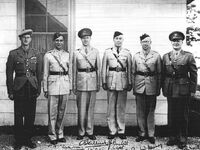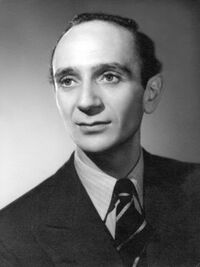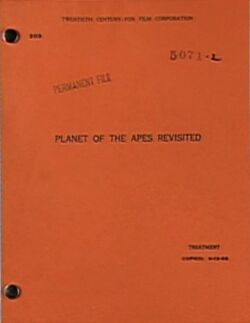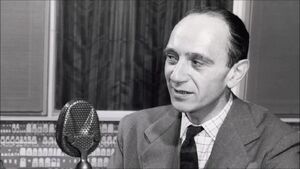Paul Dehn was born on November 5th, 1912 in Manchester, England and was educated at Shrewsbury and Oxford. He served a stint as Major in Special Forces cloak-and-dagger work during the war, from 1939 to 1945, an experience which stood him in good stead for future scenario material. Dehn began his film career, somewhat auspiciously, by receiving an Academy Award (in collaboration with James Bernard) for co-authorship of the original story for Seven Days To Noon in 1950 - his first film assignment, about a mad scientist threatening to blow up London. Prior to this success as a film writer, he had been a film critic for several newspapers including the Sunday Referee (1936-8), Sunday Chronicle (1946-53), News Chronicle (1954-60), and the Daily Herald (1960-63), an employ in which he persisted despite his obvious success. In addition to writing screenplays and film reviews, he wrote books of poetry, numerous song lyrics and sketches for musical shows, and an opera libretti. He wrote the scripts for On Such a Night (1956) and Orders To Kill (BAFTA, Best British Screenplay, 1958), both directed by Anthony Asquith, to whom Dehn’s 1956 book of collected writings For Love And Money was dedicated, and who was also a great-uncle of Helena Bonham Carter. Besides the screenplays for Beneath the Planet of the Apes, Escape from the Planet of the Apes, and Conquest of the Planet of the Apes, he also wrote scripts for Goldfinger (with Richard Maibaum, 1964), The Spy Who Came In From The Cold (1965), Fragment Of Fear (1968) and Murder on the Orient Express (Academy Award nomination, 1974). [1]
About his screen-writing career, Dehn reflected: "'Goldfinger' was utterly fantastic, and that was my first break. For twenty-five years, I was a critic in Fleet Street, working for the old 'News Chronicle', and originally when I was a critic I started writing manuscripts because I found it so hard to allocate praise and blame justly in a composite work of art like a film. The first one I wrote, in collaboration with Jimmy [James Bernard, Hammer Film composer and Dehn's professional and personal partner], was called 'Seven Days To Noon', and for which we both received an Oscar, and we also received 485 pounds from the dear Boulting brothers. So, after the Oscar film, I thought we would be rushing around writing for everybody, but two years went by and we did nothing at all. During the war I was an instructor to a band of thugs called the S.O.E. (Special Operations Executive, to which Christopher Lee was also attached for some time [as were Xan Fielding and Pierre Boulle), and I instructed them in various things on darkened estates, so I got a pretty good view of what counter espionage was like, as a result of which, when I joined the 'Daily Herald', I was offered by Anthony Asquith, a dear, dear friend of mine, the film 'Orders To Kill', because I'd had this experience during the war, and it was about an agent who went out to kill a man and found that he couldn't kill him, and this, along with my other experiences, lead to 'Goldfinger'."[1]
The writing of a sequel to the highly-successful Planet of the Apes proved to be extremely difficult for it's producers Arthur P. Jacobs and Mort Abrahams. After rejecting treatments from original screenwriter Rod Serling and original novelist Pierre Boulle, Abrahams considered Dehn: "Having read his poetry," Abrahams said, "I wondered if he would be interested. His imagery indicated such a fertile imagination that I thought his would not be the standard screenwriter's approach." Interviewed in 1972 for Cinefantastique Magazine, Dehn recalled his reaction: "I was really just asked. I'd got to know Arthur Jacobs before on a project that never came off and when 'Apes' was a big success he very kindly asked me if I would like to do a sequel and having seen the fllm, I said yes." "I've always wanted to do [science fiction] and that's why I leapt at it. I am one of those writers who like darting about from one type of film to another and when I'd collaborated on 'Goldfinger' I wanted to do a truthful spy story instead of a fantastic one which is why I did 'The Spy Who Came In From The Cold' and 'The Deadly Affair', and then I thought, "Oh God, I'm going to be typed as a spy writer," and then I did 'Taming Of The Shrew', as I've always wanted to do a Shakespearean play and that really has been the history of my life, that I don't want to get typed, and in a way it's kind of a curse, because I'm quite good at a lot of things but not very, very good at one particular thing." "I'd love to do a comedy, but I wouldn't be so knowledgeable about a western because that's something I've not done, and I feel I ought to so. I would love to do a horror film, perhaps like a Dennis Wheatley story. As you know, Jimmy [Bernard] did the music for 'The Devil Rides Out'." "Writing a screenplay entails, for me, looking at a blank wall and imagining that the film is actually going on. It isn't just a question, as so many people think it is, of writing the dialogue. Some writers, myself included, go into great detail and they have a strange physical sense and they see that film on the wall and write down what they see to the extent of putting in camera angles where they feel it's vital or camera movements, continuity devices, cutting from one thing to another. I'm inclined to go into great detail."[1]
Dehn's initial treatment, developed with Abrahams, was titled Planet of the Apes Revisited. It picked up the story of Taylor and Nova from the end of the first movie, as they travel into the Forbidden Zone and are captured by a race of radiation-mutated humans. The treatment climaxes with both an invading gorilla army and the mutants perishing in an underground nuclear explosion, while Taylor and Nova escape. They meet with their two chimpanzee allies, Cornelius and Zira, and return to Ape City to establish a new order. There is an optimistic ending in which all captive humans are freed with a new era dawning between man and ape, and, eventually, the birth of a half-human, half-ape child.[2] Although Mort Abrahams stated the story was "essentially my idea", the scripting details were contributed by Dehn: "Mort [Abrahams] was co-producer and was in at all the script conferences because this was the first 'Apes' picture that I had done. Mort didn't do any of the actual writing, but he was a wonderful 'ideas' man." "I thought there were marvellous things in the first film... [but] the extent of the culture was never very clearly defined, and that got me into considerable difficulties at the later stages, they'd invented cannons, the camera, they did scientific research and knew about vivisection. They hadn't invented the motor car as they still rode on horseback. It was difficult to decide just how far they had gone. I think the first one is, in many ways, better than the second one, where I was still feeling my way, but exciting ideas did come out of the second one as a result of the Statue of Liberty, which instantly suggested that New York was underground and that there could be relics of human civilization down there, and that gave me the idea for the mutants, people who had become radiated. At first, we were going to have them really mutated with monstrous noses and three eyes, real horror figures, but we didn't think that would have been nice for the children and after a great deal of research, it was the makeup department that came up with the idea that if you had been radiated, all seven layers of your skin would have been destroyed, and all that would be left was this terrible network of veins."[1]
Unexpectedly, Charlton Heston refused to reprise his role as Taylor for a sequel. After much persuasion from 20th Century Fox producer Richard D. Zanuck, he agreed first to appearing at the beginning, for the sake of continuity, before being replaced by another astronaut; he then agreed to appear at the beginning and reappear at the end, wherein the two astronauts and Nova would escape; finally, he suggested that the trio should instead die in the explosion in the Mutant City, and that it should be powerful enough to destroy the whole planet. Zanuck, embittered by board-room battles at Fox, liked the apocalyptic finale to the Apes saga, and pushed for it despite the objections of the director (Ted Post, who complained about the film's resulting "hodgepodge script"[1]), other cast members, and the screenwriter. "The plot of 'Apes 2' was suggested by the memorable last shot of 'Apes 1': the half-buried Statue of Liberty. This implied that New York itself lay buried beneath what the Apes called 'The Forbidden Zone'. It remained only to people the underground city with Mutants descended from the survivors of a nuclear bomb dropped on New York 2,000 years earlier, and, thus, to motivate a war between expansionist Apes and peaceable but dangerously sophisticated Mutants resulting in the final destruction of Earth." "I wanted a more optimistic end to 'Apes 2' than the destruction of Earth by the Doomsday Bomb, but my own end, the birth of a child half-human and half-monkey, proved intractable in terms of make-up, and anyway it was thought that Man-Ape miscegenation might lose us our G certificate!" "I was under strict orders not to produce a sequel. Fox said there would be no further sequels after this, kindly destroy the entire world and wind up the series. So I duly did this and as you remember at the end the world blew up, the screen went white and the earth was dead."[1]
In spite of his orders, Dehn was contacted about a third Apes movie - a seemingly impossible request, but Dehn and James Bernard devised an initial idea[3] and, without the chaos involved in the writing of Beneath, Dehn came up with a much more measured and subtle story, his favourite: "About four months later, I got a telegram from Fox saying "Apes exist, sequel required," which is why I had to move the characters backwards in time, as that was the only way round the situation, so they landed in America in 1972." "No further sequel was intended at this stage, and I was somewhat daunted (having destroyed not only the entire cast but the entire world) at being asked to provide a third instalment after the commercial success of the second. Obviously we could not go forward in time without moving to another planet - out of the question on a reduced budget - and it was only the lucky recollection of Charlton Heston's abandoned spaceship (from 'Apes 1') that suggested a way whereby three intelligent chimpanzees could travel backwards in time to the year 1973. This was the springboard for a plot in which I tried to combine satirical comedy, an Ape love-story, adventurous action and a tragic end redeemed by an unexpected 'switch'. The 'switch' was the survival of the baby chimp, whose rise to Ape Power we follow in 'Apes 4'." "The Ape films I think you can take seriously because one can make so many comments about present day life. I suppose 'Beneath the Planet of the Apes' was a little bit too much science fictiony, but my own favorite was undoubtedly 'Escape from the Planet of the Apes', which was a science fiction story, but it was about two characters, played marvellously by Kim and Roddy, and because it was a love story as well as being a comedy, and it was the first time we had used comedy in an Apes story. What I suppose you could say was that it was spectacular science fiction." "'Apes 3' was shot and directed almost exactly as I wrote it, and my relationship with the director, Don Taylor, who guided me brilliantly through the second and third drafts, was the best I have ever experienced." "'Apes 2' was, I suppose, the biggest gamble because it hadn't quite, by then, become a cult. Everyone in the series so far, 1, 2, and 3, have all made a considerable amount of money and they have been among the few that have made money for Fox, but it wasn't until the second one was completed that they realized there was going to be a continuing market for the Apes series, so in 'Escape' we left the end wide open."[1]
Dehn explained the process of bringing a movie from it's first written pages to the movie's release: "I gauge that it takes me at most ten weeks to write a first draft but in the case of 'Apes 3' the story suddenly took over and I got totally involved and the first draft was finished after three weeks, but that very rarely happens. At the end of ten weeks it goes the round of executives, the producer and officials of the company and the actors and then the comments come in and then you sit down and page by page do the first major rewrites. Then what usually happens is that the budget is made and the film usually turns out far too big, because we always think on epic lines, we must, but since the first Ape film, which was done before the slump, our budgets are much more restricted now, but we have to keep what is known as a 'big look' for the picture. In some cases, the budget restricted us in small things, for example a 'crowd' of nine apes became a 'crowd' of two apes." "...there are always cuts, because the running time is very important, and if it's supposed to be a ninety minute feature, then it's got to be, and what gets taken out, to the writer's vexation, is always his best bit of dialogue writing. There was one speech in 'Apes 3' I was deeply in love with, but they were quite right to take it out, as it added nothing to the plot at all. If we had been given another few minutes, it would probably have stayed in. If you've got a sensitive producer and director, as I have, you generally find it's a great improvement. There are things that I'd like to have seen put back which had to be cut, but I don't think there's any moment when I cringe and say, "I wish I'd changed that." " "We always have to keep the children in mind and what we want is their equivalent to our 'A' certificate, because the children have truly taken to the apes in a big way. In our own country we have the children's TV program 'Doctor. Who', which is very horrific, and the children don't really mind. Normally, we start shooting in December and have the final print issued to the distributors on May 7th, which is a mysterious date, but it's the date all the children come out of school, and according to my producer, Arthur Jacobs, that instantly makes two million more dollars."[1]
As Dehn suspected, a fourth Apes movie was indeed asked for. Conquest of the Planet of the Apes is the darkest and most violent of the Apes series, with it's graphic scenes of ape revolution, and it is often cited as the best of the sequels. "'Conquest'... is about that intermediate stage which, you remember, there was a plague of cats and dogs in 'Apes 3' which was only spoken about, when all the cats and all the dogs on Earth had died, so the human race was without pets, which was intolerable and they started looking around for something else and began to get monkeys, which was all mentioned in 'Apes 3'. The monkeys were, at first, pets like dogs, and like dogs it was found that they could be taught to do simple things, menial tasks like fetching a newspaper, bringing in master's slippers and being apes they were far more intelligent than dogs, so very soon they began to do very much more difficult things like bed making, cooking, sweeping and cleaning and they became the servants of mankind and having begun as pets they end, as our film opens, as slaves. It's a very curious thing that the 'Apes' series has always been tremendously popular with Negroes who identify themselves with the apes. They are Black Power just as the apes are Ape Power and they enjoy it greatly."[1] ('Negro' is a term used repeatedly by Dehn. The term had almost passed out of acceptable usage, but was not intended offensively, as he used it to specify powerful or sympathetic characters: the mutant leader credited only as 'Negro' in Beneath; the 'Negro Lawyer', a member of the Presidential Commission in Escape; the 'Negro Tycoons' in Conquest; and both MacDonalds were requested to be 'negro' for the purposes of the plot. Dehn also included in his script for Escape the suggestion that Dodge had been exhibited in a museum because of the dark colour of his skin compared to that of the primitive humans of the area - an idea not originally intended by writers Rod Serling and Michael Wilson, but nevertheless not contradicted by the filmed scenes. The script point was excluded from the movie, though it did appear in the film's novelization.)
Again, Dehn was told this would probably be the last movie in the series, and with that in mind he attempted to tie the film in with what was now the future events depicted in the first movie. Again, however, he knew that financial success could mean yet another sequel: "While I was out there, Arthur Jacobs said he thought ['Conquest'] would be the last so I fitted it together so that it fitted in with the beginning of 'Apes 1', so that the wheel had come full circle and one could stop there quite happily, I think. I'm afraid the true answer is to wait and see how much money this one takes, as each one has made just a little bit less each time, but one can't really tell, as they're still going the rounds around the world, so until, maybe two years time they may find that the new ones have made just as much. It is largely a question of money." "...there's room for one [further sequel] if anyone else wants to do it. I'm not backing out yet, but I'm getting a very strong feeling someone else ought to do the Ape screenplays from now on."[1]
Even at the time of his Cinefanastique interview in January 1972, there was talk of a Planet of the Apes TV series. As the principle writer of the movies, Dehn was asked if he would be involved in writing for the TV format. "[An 'Apes' television series] would have to be a little differently written. If I was asked to participate in it, I'd have to pilot the first one, and then take a continuing interest in the series, and my mind really boggles everytime I've had to do an Apes picture."[1] The Apes TV series eventually happened in late 1974, without any known contribution from Dehn.
Dehn proved to be correct about a fifth sequel, not only about it being requested, but also about the scripting duties being passed on. In fact Dehn did complete a treatment for the movie dated 5 July 1972 (just six days after the premier of Conquest), titled 'The Battle for the Planet of the Apes', but it bore little resemblance to the finished movie other than introducing the title, the characters of Mendez and Cornelius and the notion of a battle of human resistance against ape rule. As Dehn became ill, Jacobs hired screenwriters John William Corrington & Joyce Hooper Corrington to prepare a treatment. Their first draft story outline, named 'Epic of the Planet of the Apes' and dated 4 September 1972, is familiar as the broad plot of the filmed movie. However, by the time the final 'revised screenplay' was submitted in January 1973 the title had reverted to 'Battle for the Planet of the Apes' and Dehn, having become well enough to return, was solely credited for the story and co-credited with the Corringtons for the screenplay.[4] There were revisions of the treatment's dialogue and other changes to the plot which tempered the concept of Caesar altering the future (an idea central to the first Corrington treatment) in favour of Dehn's concern with bringing the saga full-circle.

'Place Paul Dehn' in Saint-Aubin d'Aubigné, France - a town he helped liberate
Following the death of Arthur P. Jacobs, Paul Dehn was no longer involved in the Planet of the Apes franchise. He spent the few remaining years of his life busying himself with TV documentaries and further film adaptations, but succumbed to lung cancer in 1976.
Notes[]

Dehn (second from left) as a British military officer
- According to journalist Sam Maronie, while visiting the set of Battle for the Planet of the Apes, actress France Nuyen mentioned that she dated Paul Dehn, 'dreamily' adding, “he writes beautiful poetry!”.[5] In fact, Dehn was in a long-term relationship with James Bernard from 1946 until his death.[6]
External Links[]
 Paul Dehn at the Internet Movie Database
Paul Dehn at the Internet Movie Database
References[]
- ↑ 1.00 1.01 1.02 1.03 1.04 1.05 1.06 1.07 1.08 1.09 1.10 'Cinefantastique Planet of the Apes Issue' (1972)
- ↑ 'Planet of the Apes Revisited' by Joe Russo and Larry Landsman
- ↑ An Interview with Composer James Bernard, Part II, by James Abbott - 'The Jade Sphinx' (14 September 2011)
- ↑ Planet of the Apes Revisited by Joe Russo and Larry Landsman (Page 211)
- ↑ When Sammy Met Roddy: Sam Maronie interview, by Dean Preston - 'Simian Scrolls' #18 (2015)
- ↑ The Mis-Shape of Things to Come: Paul Dehn's Planet of the Apes, by Neil Moxham - Bright Eyes, Ape City: Examining the Planet of the Apes Mythos (2017)



